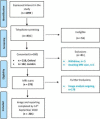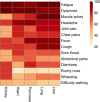Multiorgan impairment in low-risk individuals with post-COVID-19 syndrome: a prospective, community-based study
- PMID: 33785495
- PMCID: PMC8727683
- DOI: 10.1136/bmjopen-2020-048391
Multiorgan impairment in low-risk individuals with post-COVID-19 syndrome: a prospective, community-based study
Abstract
Objective: To assess medium-term organ impairment in symptomatic individuals following recovery from acute SARS-CoV-2 infection.
Design: Baseline findings from a prospective, observational cohort study.
Setting: Community-based individuals from two UK centres between 1 April and 14 September 2020.
Participants: Individuals ≥18 years with persistent symptoms following recovery from acute SARS-CoV-2 infection and age-matched healthy controls.
Intervention: Assessment of symptoms by standardised questionnaires (EQ-5D-5L, Dyspnoea-12) and organ-specific metrics by biochemical assessment and quantitative MRI.
Main outcome measures: Severe post-COVID-19 syndrome defined as ongoing respiratory symptoms and/or moderate functional impairment in activities of daily living; single-organ and multiorgan impairment (heart, lungs, kidneys, liver, pancreas, spleen) by consensus definitions at baseline investigation.
Results: 201 individuals (mean age 45, range 21-71 years, 71% female, 88% white, 32% healthcare workers) completed the baseline assessment (median of 141 days following SARS-CoV-2 infection, IQR 110-162). The study population was at low risk of COVID-19 mortality (obesity 20%, hypertension 7%, type 2 diabetes 2%, heart disease 5%), with only 19% hospitalised with COVID-19. 42% of individuals had 10 or more symptoms and 60% had severe post-COVID-19 syndrome. Fatigue (98%), muscle aches (87%), breathlessness (88%) and headaches (83%) were most frequently reported. Mild organ impairment was present in the heart (26%), lungs (11%), kidneys (4%), liver (28%), pancreas (40%) and spleen (4%), with single-organ and multiorgan impairment in 70% and 29%, respectively. Hospitalisation was associated with older age (p=0.001), non-white ethnicity (p=0.016), increased liver volume (p<0.0001), pancreatic inflammation (p<0.01), and fat accumulation in the liver (p<0.05) and pancreas (p<0.01). Severe post-COVID-19 syndrome was associated with radiological evidence of cardiac damage (myocarditis) (p<0.05).
Conclusions: In individuals at low risk of COVID-19 mortality with ongoing symptoms, 70% have impairment in one or more organs 4 months after initial COVID-19 symptoms, with implications for healthcare and public health, which have assumed low risk in young people with no comorbidities.
Trial registration number: NCT04369807; Pre-results.
Keywords: COVID-19; epidemiology; health policy; public health.
© Author(s) (or their employer(s)) 2021. Re-use permitted under CC BY. Published by BMJ.
Conflict of interest statement
Competing interests: AD, RB and MB are employees of Perspectum.
Figures





References
-
- World Health Organization . Clinical management of severe acute respiratory infection (SARI) when COVID-19 disease is suspected. interim guidance 13 March 2020, 2020. Available: https://apps.who.int/iris/handle/10665/331446
Publication types
MeSH terms
Associated data
LinkOut - more resources
Full Text Sources
Medical
Miscellaneous
